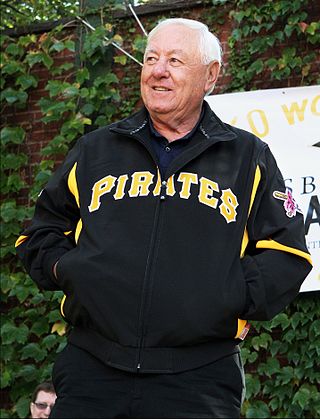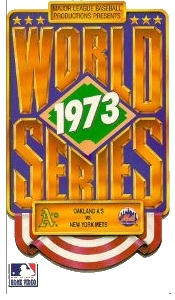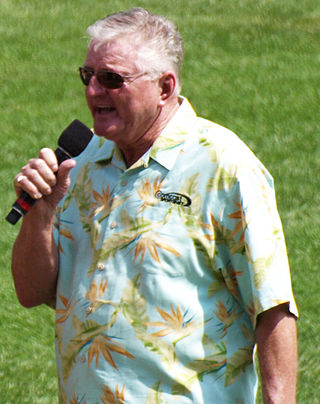
George Kenneth Griffey Jr., nicknamed "Junior" and "the Kid", is an American former professional baseball outfielder who played 22 years in Major League Baseball (MLB). He spent most of his career with the Seattle Mariners and Cincinnati Reds, along with a short stint with the Chicago White Sox. A member of the Baseball Hall of Fame and a thirteen-time All-Star, Griffey is one of the most prolific home run hitters in baseball history; his 630 home runs rank as the seventh-most in MLB history. Griffey was also an exceptional defender and won ten Gold Glove Awards in center field. He is tied for the record of most consecutive games with a home run.

Softball is a game similar to baseball played with a larger ball on a smaller field, with only underhand pitches permitted. Softball is played competitively at club levels, the college level, and the professional level. The game was first created in 1887 in Chicago by George Hancock.

In baseball, the pitcher is the player who throws ("pitches") the baseball from the pitcher's mound toward the catcher to begin each play, with the goal of retiring a batter, who attempts to either make contact with the pitched ball or draw a walk. In the numbering system used to record defensive plays, the pitcher is assigned the number 1. The pitcher is often considered the most important player on the defensive side of the game, and as such is situated at the right end of the defensive spectrum. There are many different types of pitchers, such as the starting pitcher, relief pitcher, middle reliever, lefty specialist, setup man, and the closer.

William Stanley Mazeroski, nicknamed "Maz" and "The Glove", is an American former second baseman in Major League Baseball (MLB) who played his entire career for the Pittsburgh Pirates from 1956 to 1972. A seven-time All-Star known during his career primarily for his spectacular defensive play, he has come to be better known for perhaps the most memorable home run in baseball history, a dramatic ninth-inning drive in Game 7 of the 1960 World Series that beat the favored New York Yankees. It was the first time that the major league season ended with a home run, and remains the only walk-off home run to clinch a World Series championship in Game 7. ESPN ranked the World Series winner at the top of its list of the 100 Greatest Home Runs of All Time, while Sports Illustrated had it eighth in its compilation of the 100 Greatest Moments in Sports History. Mazeroski received the Babe Ruth Award for his play in the Series, during which he batted .320.

Catcher is a position in baseball and softball. When a batter takes their turn to hit, the catcher crouches behind home plate, in front of the (home) umpire, and receives the ball from the pitcher. In addition to this primary duty, the catcher is also called upon to master many other skills in order to field the position well. The role of the catcher is similar to that of the wicket-keeper in cricket.

In baseball, the batting order or batting lineup is the sequence in which the members of the offense take their turns in batting against the pitcher. The batting order is the main component of a team's offensive strategy. In Major League Baseball, the batting order is set by the manager, who before the game begins must present the home plate umpire with two copies of his team's lineup card, a card on which a team's starting batting order is recorded. The home plate umpire keeps one copy of the lineup card of each team, and gives the second copy to the opposing manager. Once the home plate umpire gives the lineup cards to the opposing managers, the batting lineup is final and a manager can only make changes under the Official Baseball Rules governing substitutions. If a team bats out of order, it is a violation of baseball's rules and subject to penalty.
In baseball, an off-speed pitch is a pitch thrown at a slower speed than a fastball. Breaking balls and changeups are the two most common types of off-speed pitches. Very slow pitches which require the batter to provide most of the power on contact through bat speed are known as "junk" and include the knuckleball and the Eephus pitch, a sort of extreme changeup. The specific goals of off-speed pitches may vary, but in general they are used to disrupt the batter's timing, thereby lessening his chances of hitting the ball solidly or at all. Virtually all professional pitchers have at least one off-speed pitch in their repertoire. Despite the fact that most of these pitches break in some way, batters are sometimes able to anticipate them due to hints that the pitcher gives, such as changes in arm angle, arm speed, or placement of fingers.
Baseball and cricket are the best-known members of a family of related bat-and-ball games. Both have fields that are 400 feet (120 m) or more in diameter between their furthest endpoints, offensive players who can hit a thrown/"bowled" ball out of the field and run between safe areas to score runs (points) at the risk of being gotten out, and have a major game format lasting about 3 hours.

Derrel McKinley "Bud" Harrelson is a former Major League Baseball shortstop. He is a coach and part-owner of the Long Island Ducks of the Atlantic League of Professional Baseball. He played for the New York Mets, Philadelphia Phillies, and Texas Rangers from 1965 to 1980. After his retirement as a player, he served as a coach for the World Champion 1986 Mets, and as manager of the Mets in 1990 and 1991. He was inducted into the New York Mets Hall of Fame in 1986. Harrelson is the only person to take part in both of the Mets' World Series championships and appear in the first three world series for the team; he won in 1969 and appeared in the 1973 World Series as a player and in 1986 as a coach. Harrelson is also the only person in Mets franchise history to have appeared in four playoff seasons; as a player in 1969 and 1973; and as a coach in 1986 and 1988.

The 1973 World Series was the championship series of Major League Baseball's (MLB) 1973 season. The 70th edition of the World Series, it was a best-of-seven playoff played between the American League (AL) champion Oakland Athletics and the National League (NL) champion New York Mets. The Athletics won the series in seven games for their second of three consecutive World Series titles and their seventh championship overall.

Kenton Lloyd "Ken" Boyer was an American Major League Baseball (MLB) third baseman, coach and manager who played with the St. Louis Cardinals, New York Mets, Chicago White Sox, and Los Angeles Dodgers for 15 seasons, 1955 through 1969.

Kenneth Smith Harrelson, nicknamed "The Hawk" due to his distinctive profile, is an American former professional baseball player and television announcer. He played in Major League Baseball (MLB) from 1963 to 1971 as a first baseman and outfielder, and he subsequently spent 33 years as a play-by-play broadcast announcer for the Chicago White Sox. In December 2019, Harrelson was named the 2020 recipient of the Ford C. Frick Award, presented annually to one broadcaster for "major contributions to baseball".

Sports equipment, sporting equipment, also called sporting goods, are the tools, materials, apparel, and gear used to compete in a sport and varies depending on the sport. The equipment ranges from balls, nets, and protective gear like helmets. Sporting equipment can be used as protective gear or a tool used to help the athletes play the sport. Over time, sporting equipment has evolved because sports have started to require more protective gear to prevent injuries. Sporting equipment may be found in any department store or specific sporting equipment shops.

Carroll Christopher Chambliss is an American professional baseball player and coach. He played in Major League Baseball from 1971 to 1988 for the Cleveland Indians, New York Yankees and Atlanta Braves. He served as a coach for the Yankees, St. Louis Cardinals, New York Mets, Cincinnati Reds, and Seattle Mariners.

Cletis Leroy "Clete" Boyer was an American professional baseball third baseman — who occasionally played shortstop and second base — in Major League Baseball (MLB) for the Kansas City Athletics (1955–57), New York Yankees (1959–66), and Atlanta Braves (1967–71). Boyer also spent four seasons with the Taiyō Whales of Nippon Professional Baseball (NPB). In his 16-year big league career, Boyer hit 162 home runs, with 654 runs batted in (RBI), and a .242 batting average, in 1,725 games played.
Albert John Weis is an American former professional baseball player. He played in Major League Baseball as an infielder from 1962 to 1971 for the Chicago White Sox and the New York Mets. A light-hitting batter with only seven career home runs, he is notable for hitting a dramatic home run in Game 5 of the 1969 World Series. He was a switch hitter until the end of the 1968 season, after which he batted exclusively right-handed.
This is an alphabetical list of selected unofficial and specialized terms, phrases, and other jargon used in baseball, along with their definitions, including illustrative examples for many entries.
James Edward Dickson is an American retired professional baseball player, primarily a relief pitcher, who appeared in 109 games in the major leagues for the Houston Colt .45s, Cincinnati Reds and Kansas City Athletics over all or parts of four seasons from 1963 to 1966. Born in Portland, Oregon, he threw right-handed, batted left-handed, and was listed as 6 feet 1 inch (1.85 m) tall and 185 pounds (84 kg). He attended Clark College and the University of Oregon.
The 1946 National League tie-breaker series was a best-of-three playoff series that extended Major League Baseball's (MLB) 1946 regular season to decide the winner of the National League (NL) pennant. The games were played on October 1 and October 3, 1946, between the St. Louis Cardinals and Brooklyn Dodgers. It was necessary after both teams finished the season with identical win–loss records of 96–58. This was the first ever tie-breaker series in MLB history. The Cardinals won the regular season series, 16–8.














